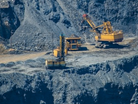Saudi opens licensing process for largest Khnaiguiyah mine

The Saudi Ministry of Industry and Mineral Resources (MIM) has opened the next stage for licensing the Khnaiguiyah site, the largest exploration site in the Kingdom.
Interested prospective investors can submit their Expression of Interest and complete their Pre-Qualification Questionnaire (PQQ) by visiting here. The award process will include three stages – qualification, proposal and auction, which could feature multiple rounds – and the Ministry expects to conclude the process in Q2.
Located in Al Rayn Terrane, Khnaiguiyah covers more than 350sqkm and forms part of the Arabian Shield, which has a potential value of $1.3trn across 48 commodities.
At the recent Future Minerals Forum, interested parties were invited to access the ministry’s data room with historical studies by visiting the Ministry’s online portal.
The PQQ requests that prospective bidders submit customary information regarding their technical knowledge and experience, capability, capacity, and organisational and financial standing, mapped to the project’s outlined criteria. The PQQ enables the Ministry to assess an organisation’s professional and technical qualifications, and competence to become the license holder. Qualified bidders are invited to submit their completed PQQ by March 14.
This tender process is based on the new Saudi Mining Investment Law, which was developed following extensive global benchmarking. The law is part of an overarching effort led by MIM to transform and attract investment in its mining sector, in line with the Kingdom’s Vision 2030, which identified mining as the third pillar of industrial growth.
Extensive exploration work already has been carried out at Khnaiguiyah site, covering 100,000m drilled and a 3D geological model. The Saudi Geological Survey has confirmed the site's considerable geological potential of approximately 26mn tons of zinc and copper, both critical minerals for the global energy transition.
As local content and communities are a top priority for Saudi Arabia as part of its commitment to ESG, the c.SAR2bn Khnaiguiyah project could potentially generate up to 3,000 direct and indirect jobs and would contribute substantially to developing the country’s zinc and copper downstream industries.
Brian Hosking, CEO, Gold & Minerals Company, said: "The Arabian-Nubian Shield is rapidly becoming a major mineral province hosting world-class mining projects. This region, along with the Tethyan-Eurasian mineral belt, are now well-recognized as having the potential to meet a large share of the world's growing demand for metals and minerals."
Douglas Kirwin, a member of the Society of Economic Geologists, said: "Mineral and metal resources are a vital part of the world's energy transition but so is the diversification of supply. Developing nations, thanks to their natural resources, are at the forefront of this transition."



